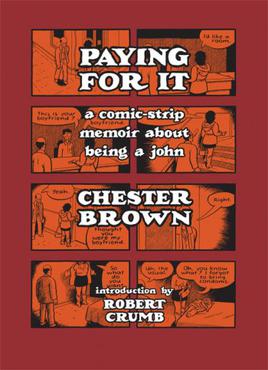Bumped by Marissa (thanks!), an autobiographical comic about being a John - the reviews have been excellent.

From the Globe and Mail:
The book begins in 1996 as his relationship with CBC Radio personality and musician Sook Yin-Lee comes to an unexpected end. While most people would wallow in self-loathing, Brown takes the news as an opportunity to explore his feelings about romance in general. Witnessing his ex’s new relationship bloom, then wither, girds him in his opinion that romantic relationships are inherently destructive.
Fast-forward a couple of years and Brown is resolved to try out prostitution as a means of satisfying his sexual desires. From there, he slowly and methodically lays out his progression through the foreign (to most of us) world of prostitution, chronicling his intimate experiences with more than two dozen prostitutes over a five-year period. Along the way, he presents his case for the decriminalization of the profession to his friends and family, which will seem self-serving to some readers.
But Brown is well aware of society’s attitudes toward prostitution and has built this book with such care and precision that I’d be shocked if even my devout Catholic mother weren’t sympathetic to his world view – at least a little.
This care is evident in the various levels that the book operates on. First and foremost, it’s an exploration and justification of prostitution as a logical option between consenting adults. But it also plays out as a tricky tale of unromantic love: a heartfelt argument against the ingrained cultural trappings of romance, and a fierce defence of the often overlooked joys of other forms of love (such as platonic, filial, interpersonal).
And it’s funny. As is the case in most of his other autobiographical comics, Brown sets himself up as the target of the jokes. Joe Matt, a good friend and recurring character in Brown’s work, gets the lion’s share of the yucks here. I especially liked Matt’s reaction after he learns Brown has visited a prostitute: “This is disturbing, but it’s also good gossip.”
Of course, the art is as idiosyncratic as ever. Brown forgoes the six-panel grid and turns down the cross-hatching that he used in Louis Riel for a small, rectangular eight-panel layout inspired in part by the comics of Carl Barks. These oblong panels house some of the year’s most effective cartooning, capable of lending dignity to even the most awkward sex scenes.
Read the rest of the article here.
And the link for the book on Amazon: here.